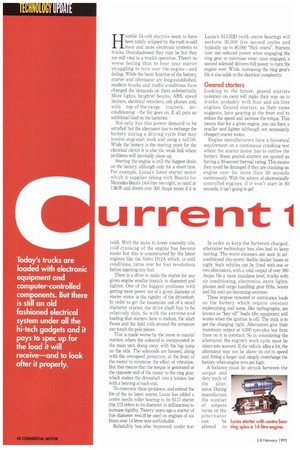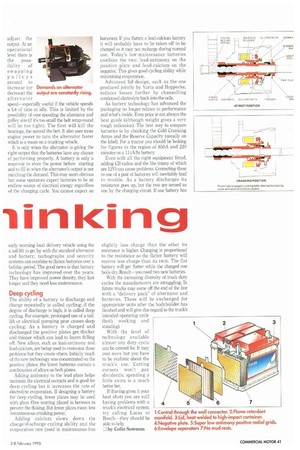urrent 1 ng
Page 42

Page 43

If you've noticed an error in this article please click here to report it so we can fix it.
Humble 24-volt electrics seem to have been totally eclipsed by the rush to add more and more electronic systems to trucks. Overshadowed they may be but they are still vital to a truck's operation. There's no worse feeling than to hear your starter struggling to turn over the engine—and failing. While the basic function of the battery, starter and alternator are long-established, modern trucks and traffic conditions have changed the demands on them substantially. More lights, brighter beams. ABS, speed limiters, electrical retarders, cab phones and, with top-of-the-range tractors, airconditioning—the list goes on. It all puts an additional load on the batteries.
Not only has this power demand to be satisfied but the alternator has to recharge the battery during a driving cycle that may involve stop-start work and using a tail-lift. While the battery is the starting point for the electrical circuit it is also the weak link where problems will inevitably show up.
Starting the engine is still the biggest drain on the battery, although only for a short time. For example, Lucas's latest starter motor which it supplies (along with Bosch) for Mercedes-Benz's 14.6-litre vee eight, is rated at 7.8kW and draws over 300 Amps (more if it is cold). With the move to lower viscosity oils, cold cranking of the engine has become easier but this is counteracted by the latest engines like the Volvo D12A which, in cold conditions, turns over for four revolutions before injecting any fuel.
There is a drive to make the starter for any given engine smaller (mainly in diameter) and lighter. One of the biggest problems with " getting more power out of a given diameter of starter motor is the rigidity of the driveshaft. In order to get the maximum out of a small diameter starter, the drive shaft has to be relatively thin. So with the extreme end loading that starters have to endure, the shaft flexes and the field coils around the armature can touch the pole pieces.
This is made worse by the move to coaxial starters where the solenoid is incorporated in the main unit, doing away with the big lump on the side. The solenoids are housed, along with the overspeed protection, at the front of the motor to minimise the effect of vibration. But this means that the torque is generated at the opposite end of the motor to the ring gear, which makes the driveshaft into a torsion bar with a bearing at each end.
To overcome these problems, and extend the life of the its latest starter, Lucas has added a centre needle roller bearing to its S115 starter (the 115 refers to its diameter in millimetres) to increase rigidity Twenty years ago a starter of this diameter would be used on engines of six litres; over 14 litres was unthinkable.
Reliability has also improved; under test Lucas's S115HD (with centre bearing) will perform 30,000 five second cycles and typically up to 80,000 "flick starts". Starters now use reduced power when engaging the ring gear to minimise wear; once engaged, a second solenoid delivers full power to turn the engine over. While increasing the ring gear's life it also adds to the electrical complexity.
Geared starters
Looking to the future, geared starters (common on cars) will make their way on to trucks, probably with four and six-litre engines. Geared starters, as their name suggests, have gearing at the front end to reduce the speed and increase the torque. This means that for a given engine, you can have a smaller and lighter (although not necessarily cheaper) starter motor.
Engine manufacturers have a historical requirement on a continuous cranking test where the starter motor has to outlive the battery. Some geared starters are quoted as having a 30-second thermal rating. This means they could be damaged if they are cranking an engine over for more than 30 seconds continuously. With the advent of electronically controlled engines, if it won't start in 30 seconds, it isn't going to go!
In order to keep the batteries charged, alternator technology has also had to keep moving. The worst excesses are seen in airconditioned city-centre double decker buses at night. Such vehicles can be fitted with one or two alternators, with a total output of over 300 Amps. On a more mundane level, trucks with air conditioning, electronics, extra lights, phones and cargo handling gear (lifts, hoists and the rest) are becoming common.
These impose repeated or continuous loads on the battery which require constant replenishing and some, like tachographs, are known as "key off" loads (the equipment still works when the ignition is off). The trick is to get the charging right. Alternators give their maximum output at 4,000 rpm-plus but from there on it is constant. So in considering the alternator, the engine's work cycle must be taken into account. If the vehicle idles a lot, the alternator may not be above its cut-in speed and fitting a larger unit simply overcharge the battery when engine revs are high.
A balance must be struck between the output and duty cycle of the alter nator. During manufacture the number of ampere turns on the alternator can be altered to adjust the output. At an operational level there is the poss ibility of SW apping pulleys around to increase (or decrease) the alternator speed—especially useful if the vehicle spends a lot of time at idle. This is limited by the possibility of over-speeding the alternator and pulley size (if it's too small the belt wrap-round will be too tight). The first will kill the bearings, the second the belt. It also uses more engine power to turn the alternator faster which is a waste on a trunking vehicle.
It is only when the alternator is giving the right output that the batteries have any chance of performing properly. A battery is only a reservoir to store the power before starting and to fill in when the alternator's output is not matching the demand. This may seem obvious but some operators expect batteries to be an endless source of electrical energy regardless of the charging cycle. You cannot expect an Demands on alternator output are constantly rising.
early morning local delivery vehicle using the a tail-lift to get by with the standard alternator and battery; tachographs and security systems can combine to flatten batteries over a holiday period. The good news is that battery technology has improved over the years. They have improved power density, they last longer and they need less maintenance.
Deep cycling
The ability of a battery to discharge and charge repeatedly is called cycling; if the degree of discharge is high, it is called deep cycling. For example, prolonged use of a taillift or electrical pumping gear causes deep cycling. As a battery is charged and discharged the positive plates get thicker and thinner which can lead to layers falling off. New alloys, such as lead-antimony and lead-calcium, are being used to overcome these problems but they create others. Initially much of the new technology was concentrated on the positive plates: the latest batteries contain a combination of alloys on both plates.
Adding antimony to the lead plate helps maintain the electrical contacts and is good for deep cycling but it increases the rate of electrolyte evaporation. If designing a battery for deep cycling, fewer plates may be used with glass fibre matting placed in between to prevent the flaking. But fewer plates mean less instantaneous cranking power.
Adding calcium slows down the chargeldischarge cycling ability and the evaporation rate (used in maintenance-free batteries). If you flatten a lead-calcium battery it will probably have to be taken off to be charged as it may not recharge during normal use. Today's low-maintenance batteries combine the two: lead.antimony on the positive plate and lead-calcium on the negative. This gives good cycling ability while minimising evaporation.
Advanced lid design, such as the one produced jointly by Varta and Hoppecke, reduces losses further by channelling condensed electrolyte back into the cells.
As battery technology has advanced the packaging no longer relates to performance and what's inside. Even price is not always the best guide (although weight gives a very rough indication). The best way to compare batteries is by checking the Cold Cranking Amps and the Reserve Capacity (usually on the label). For a tractor you should be looking for figures in the region of 850A and 220 minutes on a 114A/hr battery.
Even with all the right equipment fitted, adding CB radios and the like (many of which are 12V) can cause problems. Connecting these to one of a pair of batteries will inevitably lead to trouble. As a battery discharges its resistance goes up, but the two are sensed as one by the charging circuit. If one battery has slightly less charge than the other its resistance is higher. Charging is proportional to the resistance so the flatter battery will receive less charge than its twin. The flat battery will get flatter while the charged one boils dry. Result—you need two new batteries.
With the increasing diversity of truck duty cycles the manufacturers are struggling. In future trucks may come off the end of the line with a "delivery pack" of alternator and batteries. These will be exchanged for appropriate units after the bodybuilder has finished and will give due regard to the truck's intended operating cycle (both working and standing).
With the level of technology available almost any duty cycle can be catered for. It may cost more but you have to be realistic about the truck's use. Cutting corners won't pay dividends: spending a little extra is a much better bet.
If (having given it your best shot) you are still having problems with a truck's electrical system try calling Lucas or Bosch—they should be able to help.
by Colin Sowman
































































































